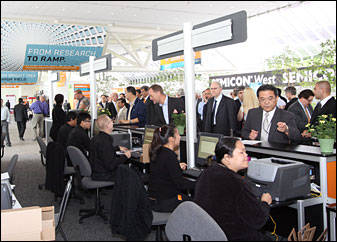By Hank Hogan, Contributing Editor
SAN FRANCISCO, July 16, 2010 — This year's upbeat Semicon West is in stark contrast to last year's world-is-ending trade show. In an opening press conference, Stanley Myers, president and CEO of the trade organization SEMI, painted a picture of more demand for more silicon driving the need for more equipment.
"This is all good news," he said.
Myers likened the industry's steep climb this year from the depths of the 2009 trough to a car driving up a hill, with nothing but blue sky in sight. But he also added a note of caution. "We don't really know what will be over that hill."
For now, though, times are good, with forecasts for growth in the semiconductor market running between 25 and 33 percent. That is being accompanied by a firming of chip average selling prices and a fab utilization rate of 93 percent in the first quarter.

Participants register for Semicon West in the South Hall of San Francisco's Moscone Center. (Photo: SEMI)
According to SEMI, the average three-month equipment book-to-bill ratio for North American manufacturers has been above 1, indicating growth, for a year. Spending for fab equipment will more than double this year, to more than $30 billion. LED fabs alone will spend $1.3 billion on equipment.
Those positives have translated into 630 companies exhibiting at the show, with nearly half touting new products. There also was a 14 percent year-to-year increase in show attendance. Although final figures won't be known for weeks, registration for Semicon West this year looks to be upward of 25,000, with some hints that it could be close to the 30,000 figure.
The crowds inside the convention center indicate that things are looking up. Further confirmation comes from spot checks about show traffic with equipment suppliers such as industrial microscope vendor Olympus America and material suppliers such as gas and chemical provider Air Liquide.
Another sign of the growth of both Semicon West and the colocated Intersolar North America is the fact that many activities are being held outside the convention hall. For example, there's ASMC, the advanced semiconductor manufacturing conference, which was held in a nearby hotel. Talks at ASMC outlined some of the challenges the industry faces, such as how to build 3-D integrated circuits with high-density interconnects in high volumes.
These challenges highlight a problem equipment suppliers face. The spending on equipment as a percentage of total semiconductor revenue has been dropping. Traditionally, it has been about 15 percent. In 2008 and 2009, it was less than that; last year's 7 percent was the lowest in 20 years. Going forward, SEMI projects, it will be about 11 percent, a figure that worries some because of its impact on the industry's future.
"I'm concerned we may not be investing enough," said SEMI's Myers.
At the ending keynote for ASMC, Bill McClean, president of the Scottsdale, Ariz.-based analyst firm IC Insights, offered a slightly more optimistic take. He noted that a firming in average chip selling price, along with continued growth in the semiconductor market, should lead to a stabilization of the situation for equipment suppliers. In the past, they had to contend with a shrinking share of semiconductor revenue. In the future, they won't.
Going forward, McClean said, they can expect growth to be about the same as that of the overall semiconductor market. That should translate into a compound annual growth rate of 8 to 10 percent.
Ongoing industry consolidation should also lead to a smoothing out of the business cycle. McClean noted that 10 companies can all have reasonable plans to capture 15 percent of the total market, but if they all try to do so at once, the result is the classic semiconductor boom and bust. With fewer companies, there's less chance that market demand will be misjudged and excess capacity built.
However, he doesn't expect the valleys to go away entirely. Predicting when the next will occur is difficult, but 2013 might be a good bet, he said. It could come sooner, as there are signs that inventory may be building up for cell phone chips.
While it may be difficult to pinpoint when a semiconductor downturn will occur, it's certain that one will happen. It's due in part to the fact that these are good times, said McClean.
As he noted in talking about past ups and downs, "If you know what part of the cycle you're in, you know what's coming."
Hank Hogan
[email protected]